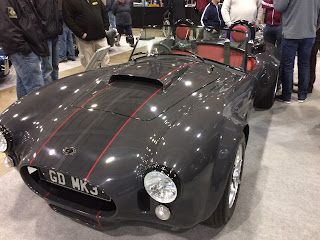The head restraints supplied by GD restricted how far back the seats could be pushed back. So to address this I modified them! Now I have an extra 40-45mm of travel in the seats.
The head restraints were removed from the seats. The head restraint was placed on a flat surface upside down and by putting a metal ruler against it, a line was marked in chalk 150mm up (so 150mm from the top).
 |
| Line in chalk 150mm up |
Next the sides were marked in chalk. These side lines were marked from the line across the back parallel down to the metal location bars and finished about 12mm behind the bars (you can see how much will be removed).
 |
| Line in chalk across side |
The leather cover was then removed by releasing the Velcro and then compressing the foam of the head restraint, taking care not to rub off the chalk lines. The measurement/markings were then transferred on to the head restraint leatherette. The three pieces of Velcro were removed from the cover and retained for later use. I turned the cover inside out and then unpicked the sewn seams at both sides from the bottom up to the line that went across the head restraint. There were two rows of stitches (a hidden seam stitch - black in my case and a top stitch - red for mine). The threads were then knotted on the reverse and a covering of contact adhesive applied. These two actions should stop the stitching unravelling further. The leather cover was put to one side.
 |
| Leather head restraint cover removed |
The surface of the leatherette head restraints were then cut downwards from the line drawn to about 12mm from the head restraint location bars underneath. It was then cut across just above the bottom roll (leaving a lower flap for glueing). This formed an H shape cut (see photo below).
 |
| Leatherette cut in H shape on head restraint |
The leatherette was lifted from the foam underneath. The foam that protruded was removed (try a hacksaw to get a smooth surface, but watch you don't cut any leatherette), as was any residual foam still attached to the leatherette of the back, bottom and side flaps. The top flap had about 5mm removed from the across the bottom (the exact amount can be established by pulling the leatherette tight and marking a line across the flap over a flat area of the head restraint, to remove any excess). The side flaps were carefully thinned, then the top flap was thinned for a strip about 12mm deep across the width. The side flap (a triangle) was marked on the reverse of the top flap and this too was thinned.
 |
| Head restraint being operated on! |
Contact adhesive was applied to the foam, the reverse of the bottom flap, the reverse of the top flap including the thinned area, the reverse of the thinned side flaps, the leatherette faces of the side flaps, the leatherette face of the lower flap (about 10mm across the width). Once touch dry, the bottom flap, followed by the side flaps were pressed in to place. Finally the larger top flap was pressed in to place on to the foam.
The cover was fitted over the head restraint and the new position of the Velcro marked with chalk. The cover was removed, then the Velcro was glued and machine sewn in place. The stitching was redone by hand, down 45mm below the chalk line - both the seam and the top stitch. The remainder of the seams were simply top stitched for continuity. Finally, after refitting the cover again, it was tightened in place, using the Velcro. The remaining bits at the bottom corners were glued in place to make a neat job.
 |
Head restraint in place liberates about 40mm of extra seat travel,
a further 70-75mm is available if the head restraints are not fitted.
|
The modified head restraints have removed a fair bit of the padding at the bottom back which touched the rear bodywork. This now allows the seats to be pushed back a further 40mm or so.





























